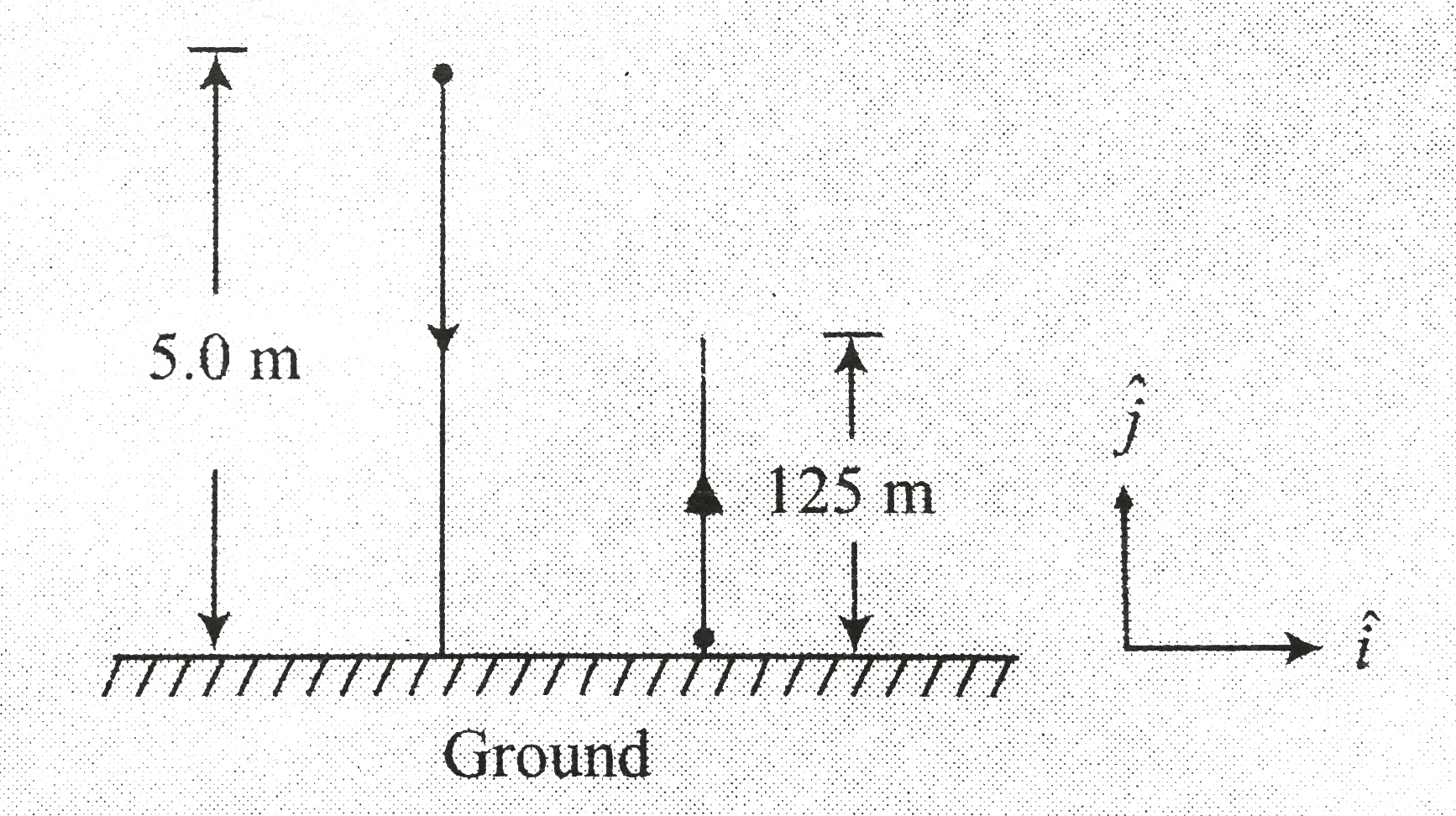A rubber ball is released from 5m height and bounces to 81/100 of its height every time. Find its average speed.
To find the average speed of a rubber ball released from a height of 5 meters and bouncing back to 81/100 of its height every time, we can follow these steps:
Step 1: Determine the heights of the bounces
The initial height H0 is given as 5 meters. The height after the first bounce H1 can be calculated as:
H1=81100H0=81100×5=4.05 meters
The height after the second bounce H2 is:
H2=81100H1=81100×4.05=3.2845 meters
Continuing this pattern, the height after the n-th bounce can be expressed as:
Hn=H0(81100)n
Step 2: Calculate the total distance traveled by the ball
The total distance S traveled by the ball includes the initial drop and the subsequent bounces. The distance can be calculated as follows:
S=H0+2(H1+H2+H3+…)
The series H1+H2+H3+… is a geometric series where:
- First term a=H1=4.05
- Common ratio r=81100
The sum of an infinite geometric series is given by:
Sum=a1−r
Thus, we can find the sum of the heights after the first drop:
H1+H2+H3+…=4.051−81100=4.0519100=4.05×10019≈21.3684 meters
Now substituting back into the total distance:
S=5+2×21.3684≈5+42.7368=47.7368 meters
Step 3: Calculate the total time taken for the bounces
The time taken to fall from the height H can be calculated using the equation of motion:
t=√2Hg
where g is the acceleration due to gravity (approximately 10m/s2).
The time for the first drop t0 is:
t0=√2H0g=√2×510=√1=1 second
For the subsequent bounces, the time taken for each height can be calculated similarly:
t1=√2H1g=√2×4.0510≈0.9 seconds
t2=√2H2g≈√2×3.284510≈0.81 seconds
Continuing this pattern, the total time T can be expressed as:
T=t0+2(t1+t2+t3+…)
The series t1+t2+t3+… is also a geometric series:
tn=√2H0g(81100)n/2
The first term t1=0.9 and common ratio r=√81100=910.
Calculating the sum:
t1+t2+t3+…=0.91−910=0.9×10=9 seconds
Thus, the total time is:
T=1+2×9=19 seconds
Step 4: Calculate the average speed
The average speed Vavg is given by:
Vavg=ST=47.736819≈2.51 m/s
Final Answer
The average speed of the rubber ball is approximately 2.51m/s.
---
The initial height H0 is given as 5 meters. The height after the first bounce H1 can be calculated as:
H1=81100H0=81100×5=4.05 meters
The height after the second bounce H2 is:
H2=81100H1=81100×4.05=3.2845 meters
Continuing this pattern, the height after the n-th bounce can be expressed as:
Hn=H0(81100)n
The total distance S traveled by the ball includes the initial drop and the subsequent bounces. The distance can be calculated as follows:
S=H0+2(H1+H2+H3+…)
The series H1+H2+H3+… is a geometric series where:
- First term a=H1=4.05
- Common ratio r=81100
Sum=a1−r
Thus, we can find the sum of the heights after the first drop:
H1+H2+H3+…=4.051−81100=4.0519100=4.05×10019≈21.3684 meters
Now substituting back into the total distance:
S=5+2×21.3684≈5+42.7368=47.7368 meters
The time taken to fall from the height H can be calculated using the equation of motion:
t=√2Hg
where g is the acceleration due to gravity (approximately 10m/s2).
t0=√2H0g=√2×510=√1=1 second
For the subsequent bounces, the time taken for each height can be calculated similarly:
t1=√2H1g=√2×4.0510≈0.9 seconds
t2=√2H2g≈√2×3.284510≈0.81 seconds
Continuing this pattern, the total time T can be expressed as:
T=t0+2(t1+t2+t3+…)
The series t1+t2+t3+… is also a geometric series:
tn=√2H0g(81100)n/2
The first term t1=0.9 and common ratio r=√81100=910.
t1+t2+t3+…=0.91−910=0.9×10=9 seconds
Thus, the total time is:
T=1+2×9=19 seconds
The average speed Vavg is given by:
Vavg=ST=47.736819≈2.51 m/s
The average speed of the rubber ball is approximately 2.51m/s.
Topper's Solved these Questions
- JEE MAIN 2021BOOK - JEE MAINS PREVIOUS YEARCHAPTER - JEE MAIN 2021EXERCISE - SECTION-A
80 Videos
- JEE MAIN 2021BOOK - JEE MAINS PREVIOUS YEARCHAPTER - JEE MAIN 2021EXERCISE - SECTION-B
40 Videos
- JEE MAINBOOK - JEE MAINS PREVIOUS YEARCHAPTER - JEE MAINEXERCISE - All Questions
473 Videos
- JEE MAIN 2022BOOK - JEE MAINS PREVIOUS YEARCHAPTER - JEE MAIN 2022EXERCISE - Question
492 Videos
Similar Questions
A rubber ball is thrown from a height of 10m. It bounces back to 90% of its previous height after every bounce.Find its height after two bounces?
View SolutionA rubber ball is dropped from a height of 5 m on a plane. If bounces back to a height of 1.8 m. Find the coefficient of the resitution for the collision.
View Solution
Knowledge Check
A ball is released from certain height. It loses 50% of its kinetic energy on striking the ground. It will attain a height again equal to
AOne fourth the initial heightBHalf the initial heightCThree fourth initial heightDNone of theseA particle is released from a height h. At a certain height, its kinetic energy is two times its potential energy. Height and speed of the particle at that instant are
Ah3√2gh3Bh32√gh3C2h3√2gh3Dh3√2gh
A rebber ball is released from a height aboout 1.5m. If is caught after three bounces. Skerch graphs of ist position, velocity, and acceleration as functions of time. Take positive y-direction as upwrad direction.
View SolutionA rubber ball of mass 50 g falls from a height of 5m and rebounds to a height of 1.25 m. Find the impulse and the average force between the ball and the ground if the time for which they are in contact was 0.1s

View SolutionA rubber ball of mass 50g falls from a height of 100cm and rebounds to a height of 50cm Find the impulse and average force between the ball and the ground, if time of contact is 0.1s .
View SolutionA rubber ball is released from a height of 5 m above the floor. It bounces hack repeatedly. always rising to 81100 of the height through which it falls. Find the average speed of the ball.
(Take g=10ms−2)
View SolutionA ball is released from the top of a building of height 45m at t=0 . When the ball strikes the ground, its speed becomes 23 times its original value. The time instant when the ball strikes the ground for the second time is t = ...........sec .[Takeg=10m/s2]
View SolutionA ball is released from some height & rebounds with same speed after hitting the ground.If it travels 20m in first 8 seconds find the no of collision.
View Solution
